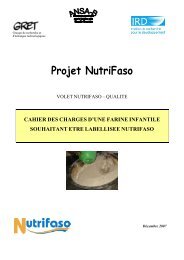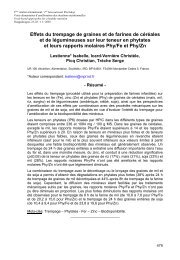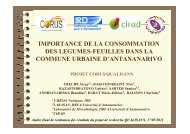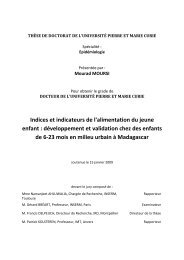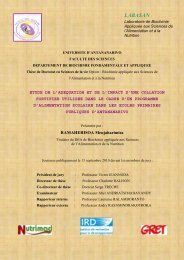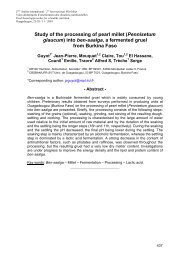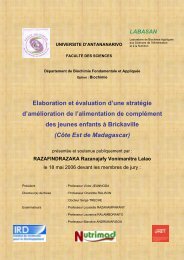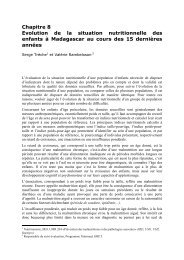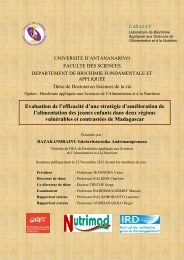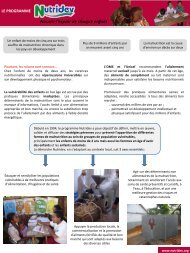THESE UNIQUE El Hassane Kéhien-Piho TOU - Nutridev
THESE UNIQUE El Hassane Kéhien-Piho TOU - Nutridev
THESE UNIQUE El Hassane Kéhien-Piho TOU - Nutridev
Create successful ePaper yourself
Turn your PDF publications into a flip-book with our unique Google optimized e-Paper software.
936 E.H. Tou et al. / Food Chemistry 100 (2007) 935–943<br />
complementary foods for infants. The addition of a-amylase<br />
from commercial sources or produced from germinated<br />
cereals to gelatinize starch proved to be an efficient<br />
method (Kitabatake, Gimbi, & Oi, 2003; Mosha & Svanberg,<br />
1983; Thaoge et al., 2003). Recently, several studies<br />
tested the combination of the use of germinated cereals<br />
and fermentation to increase gruel ED (Thaoge et al., 2003).<br />
Ben-saalga is a pearl millet-based fermented gruel widely<br />
consumed by infants and young children in Ouagadougou<br />
(Burkina Faso). As it is the case in many other traditional<br />
cereal-based fermented gruels, the dry matter content of<br />
ben-saalga is very low (Guyot et al., 2003) and consequently<br />
its ED is not high enough to meet the energy<br />
requirements of infants and young children. Modifications<br />
of the traditional processing method are required to produce<br />
an improved gruel with the suitable characteristics.<br />
The present work aimed at increasing the ED of this fermented<br />
gruel by implementing three different combinations<br />
of processes (pre-cooking, addition of malt flour and inoculation<br />
by back-slopping) in addition to the processes traditionally<br />
used to produce ben-saalga. These processes were<br />
chosen according to their potential ability to favour partial<br />
starch hydrolysis (pre-cooking and addition of malt) and<br />
also to promote rapid acidification by lactic acid fermentation<br />
(back-slopping) to improve hygienic conditions (Nout,<br />
Rombouts, & Havelaar, 1989). In addition to the assessment<br />
of the influence of these processes on the fermented<br />
gruel ED, special attention was paid to their effects on fermentation<br />
kinetics and on microflora.<br />
2. Materials and methods<br />
2.1. Materials<br />
Pearl millet (Pennisetum glaucum) and aromatic ingredients<br />
such as ginger and mint used in the preparation of<br />
ben-saalga were purchased on the retail market in Ouagadougou.<br />
Malted grains of barley were obtained from Brakina,<br />
an industrial brewery in Ouagadougou.<br />
2.2. Description of the processing conditions<br />
The traditional processing of pearl millet into ben-saalga<br />
has been previously described in details (Tou et al., in<br />
press). It comprises the following main steps: washing,<br />
soaking the pearl millet grains and milling them in wet conditions,<br />
kneading and sieving the dough, settling the<br />
diluted slurry to allow natural fermentation to occur (fermentation<br />
step) and cooking the fermented slurry to obtain<br />
the gruel ben-saalga. The flow chart of traditional processing<br />
method (used as control), and the process combinations<br />
including new processes are presented in Fig. 1. These<br />
experiments were performed at pilot-scale using the facilities<br />
of the University of Ouagadougou, in the same conditions<br />
and with the same raw materials as local producers.<br />
Results are means of triplicate experiments for control<br />
and process combinations. The innovations introduced in<br />
the traditional process consisted in different process combinations:<br />
pre-cooking, addition of malt and inoculation by<br />
back-slopping of the slurry obtained after the sieving/<br />
kneading step. The process combinations were called<br />
‘‘CI’’ for the combination of pre-cooking and inoculation,<br />
‘‘CM’’ for the combination of pre-cooking and addition of<br />
malt and ‘‘CMI’’ for the combination of the three processes.<br />
The conditions for each process (pre-cooking, addition<br />
of malt and inoculation) are described below.<br />
2.2.1. Pre-cooking step (C)<br />
The pre-cooking step consisted in boiling the unfermented<br />
slurry resulting from sieving for 10 min to gelatinize<br />
the starch and to allow either the action of malt<br />
amylase in CM and CMI process combinations or the possible<br />
action of amylases produced by the natural microflora<br />
introduced by the inoculation.<br />
2.2.2. Incorporation of malt (M)<br />
Malted grains of barley were milled and sieved to obtain<br />
the malt flour used as the source of amylase. The malt flour<br />
was used at the rate of 0.125 g/100 g of the dry matter (DM)<br />
of the wet flour. It was added to the unfermented paste,<br />
when it had cooled down to 65 °C, 10–20 min after cooking.<br />
2.2.3. Inoculation (I)<br />
Inoculation of the paste by the back-slopping technique<br />
was used to favour fermentation after pre-cooking. A portion<br />
of fermented paste prepared the day before according<br />
to the traditional processing method was used as inoculum.<br />
It was added at a rate of 10% (w/w) to the unfermented<br />
paste after the addition of malt, when it had cooled down<br />
to 35 °C, after 2–3 h.<br />
2.3. Preparation of gruels<br />
For each experiment, five gruels were prepared at different<br />
DM contents by boiling the fermented paste for at least<br />
5 min. The dry matter content of gruels was determined by<br />
oven-drying at 105 °C to constant weight. The consistency<br />
of the gruels was assessed by measurement in a Bostwick<br />
consistometer (CSC Scientific Company Inc., Fairfax,<br />
VA, USA) (Bookwalter, Peplinski, & Pfeifer, 1968). Measurements<br />
were made at 45 °C and the Bostwick flow value<br />
was expressed in mm/30 s. The ED of gruels was calculated<br />
by multiplying their dry matter content by 4 kcal, which<br />
was taken as the mean energy value of 1 g of DM. This<br />
ED was calculated for gruels with a suitable consistency,<br />
corresponding to a Bostwick flow of 120 mm/30 s (Vieu<br />
et al., 2001).<br />
2.4. Fermentation kinetics<br />
Samples were taken during the fermentation step (from<br />
0 to 24 h) of the different process combinations and of the<br />
control experiment. The pH was recorded on-line using a<br />
pH-meter register (WTW 340i, Fisher Bioblock Scientific,



